As an Amazon Associate, we earn from qualifying purchases with no additional costs for you.
If you are looking for Japanese kitchen knives to chop and process vegetables, then you have many you can choose from. There are some Japanese kitchen knives that are purpose-built for the job of processing vegetable ingredients, and there are others that can be used in this role due to their multi-purpose capabilities. They also can be used to slice meat or cut up a roast chicken in preparation for cooking.
The following 8 Japanese knives are best for chopping vegetables. However, a combination of two or three knives would be the ideal option, such as a Nakiri and a Santoku combination.
- Nakiri
- Usuba
- Santoku
- Gyuto
- Bunka
- Funayuki
- Mukimono
- Petty
Since Japanese kitchen knives are built with a particular kitchen task in mind, some of these knives will simply not function well in the role of processing vegetable ingredients. However, there are some Japanese knives that are created for this purpose.
We will take a look at these and also other styles of Japanese knives that can be used in the role, even though it is not their primary function. This information will help you to make a decision as to the best Japanese knife for your vegetable chopping needs.
If you are interested in checking out the best Japanese knives for chopping and cutting vegetables (made by Hayate Yoshihiro), we recommend and use them. You can find them by clicking here (Amazon link).
The Best Japanese Knives For Chopping And Cutting Vegetables

The reason that Japanese kitchen knives are sought-after tools in the kitchen and are often considered the best tools for the job comes from their history, purpose, steel, and design.
The Japanese have been processing steel for a much longer time than most of the rest of the world, and the mineral deposits they have for making steel make for very durable, robust, and sharp-edged knives.
The Japanese are also known for their attention to detail and their craftsmanship, and the demand for perfection in their culture. As a result, the kitchen knives that they produce are masterpieces in workmanship and in the function that they were designed to perform.
We will first discuss the knives that are specifically made for vegetable chopping and then move on to some knives where processing vegetables are included in their range of functions, even though it is not the sole purpose for the knife.
The following Japanese knives can be used in the kitchen for the processing of vegetables.
- The Nakiri, a popular choice.
- Usuba, which is the choice for professionals.
- The Santoku, which gives versatility.
- The Gyuto, which also serves other purposes in the kitchen.
- Bunka, a general-purpose knife that works great on vegetables.
- Funayuki for rough and ready durability and versatility.
- The Mukimono is a specialized knife that adds vegetable processing flair.
- Petty, which will work for fine work and smaller tasks.
We will take a look at these knives individually to showcase their characteristics and suitability for processing vegetables in the kitchen.
1. Nakiri
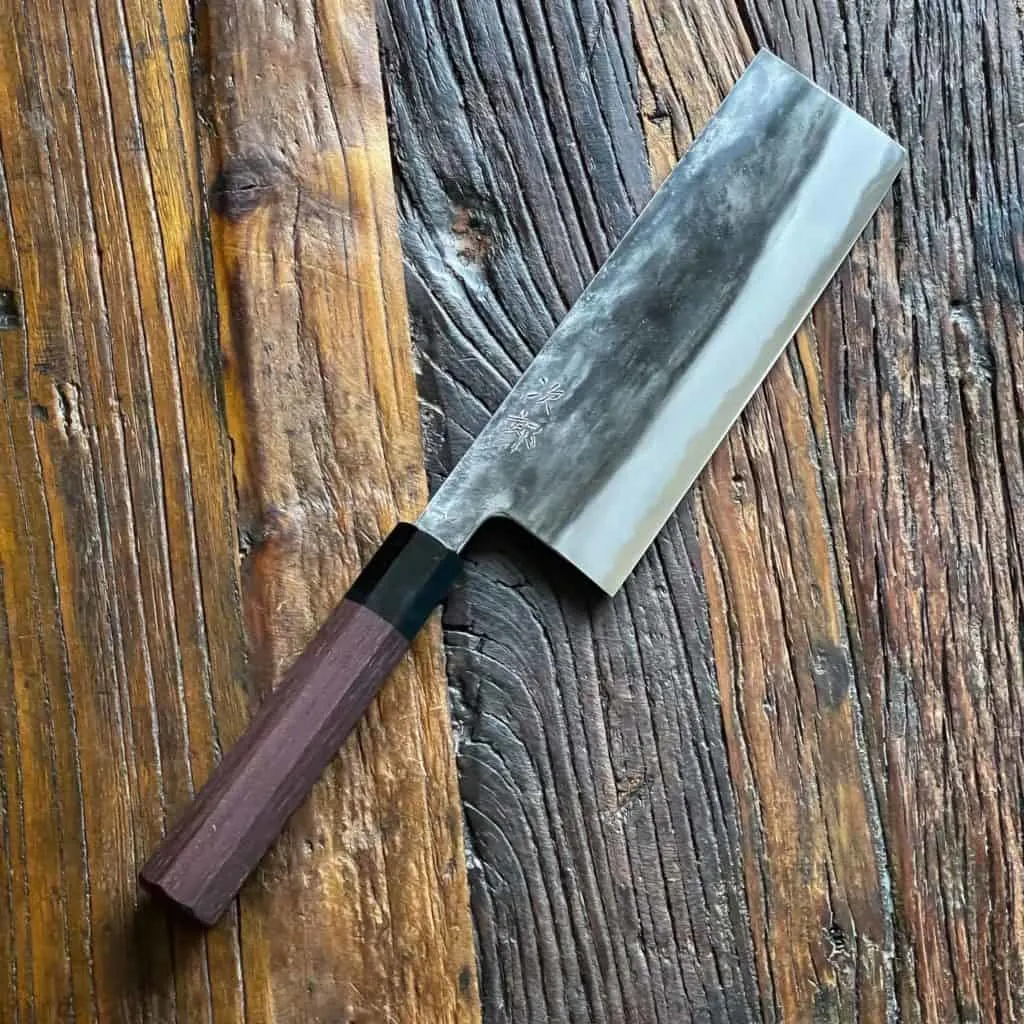
The Nakiri is probably the quintessential Japanese vegetable processing knife among Japanese kitchen knives. The Nakiri looks very similar to a cleaver, and it is essentially a cleaver for vegetables but has a lot more finesse than a meat cleaver.
This knife is shaped very similarly to a meat cleaver, and you may mistake it for one at first glance. It is a square-looking blade, which is not only for looks. The square tip changes the feel of the knife to that of being robust yet secure in the hand.
The Nakiri is one Japanese knife that is traditionally made as a double-beveled blade rather than the single bevel style, which is more common in Japanese knives.
The cutting edge of the Nakiri is straight, without any curve in it except toward the very tip of the knife, where it subtly sweeps up into the square tip.
These knives come in various sizes, ranging from 6.5-inch blades to 7-inch blades. The blade is quite tall, usually up to 2.1 inches tall, but taller options up to 3 inches are available as well.
The height of the blade is a design feature that gives your knuckles clearance above the surface that you are chopping the vegetables on.
The Nakiri is considered to be a household knife, and it is popular across all of Japan, which is why you will find this knife in most Japanese household kitchens as well as professional kitchens.
The steel that these knives are made from allows the edge to be remarkably thin for a knife of this size, which makes it a great performer for slicing and chopping vegetables.
The shape of the blade makes the Nakiri useful for slicing with a push cut as well as a straight-up and down chopping action. Chopping with a rocking action can be done with this knife but can feel a little awkward when used in this way.
If you are interested in buying a high-quality Nakiri knife we recommend checking out this knife made by the Yoshihiro company (Amazon link).
TIP: Nakiri is definitely the perfect knife for chopping vegetables. But not only! You will find 10 more reasons in the article below why you need a Nakiri knife in your kitchen!
10 Reasons You Need A Nakiri Knife
2. Usuba
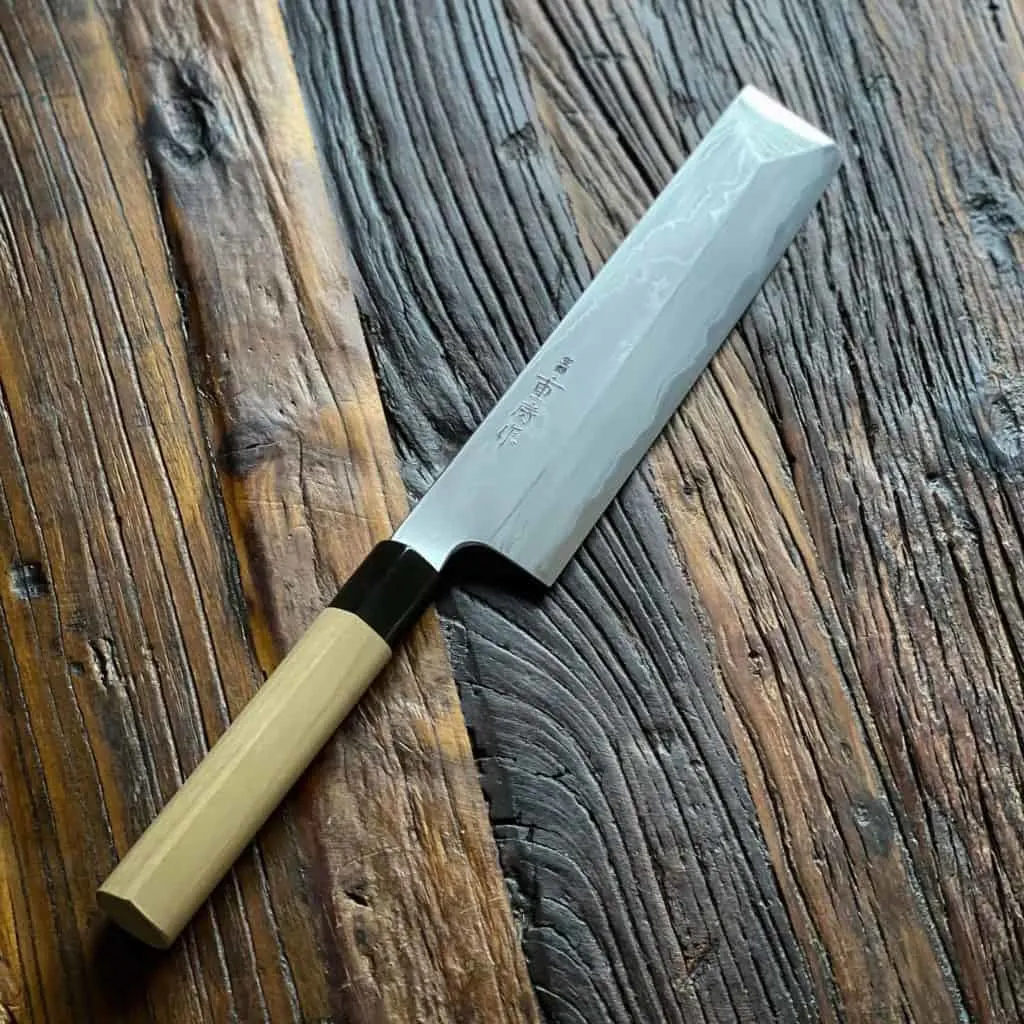
The Usuba is a Japanese knife that you don’t hear about too much as being a common choice as a vegetable knife, but it is a vegetable knife nonetheless. It essentially is exactly the same as the Nakiri except for one important characteristic.
The Usuba is a single bevel knife, which means that only one side of the knife has a bevel that tapers to the sharp cutting edge of the knife; the other side of the knife is flat. You may hear this grind referred to as a chisel grind.
The single bevel design on a knife allows it to be much sharper than a double bevel knife, and it can be used to perform much more precise, delicate, and finer cuts on the ingredients.
The result is clean cuts that make the food look better but also preserve the flavor of delicate foods better because the ingredient is not bruised or crushed.
The downside of a single bevel blade is that it is difficult to sharpen. For this reason, this knife is generally only used in professional kitchens.
These knives will normally be outsourced to a professional knife sharpening service to get sharpened. These knives are not often seen in the Western world, as the Nakiri is more popular for this function.
If you are interested in buying a high-quality Usuba knife, we recommend checking out this knife made by the Yoshihiro company (Amazon link).
3. Santoku
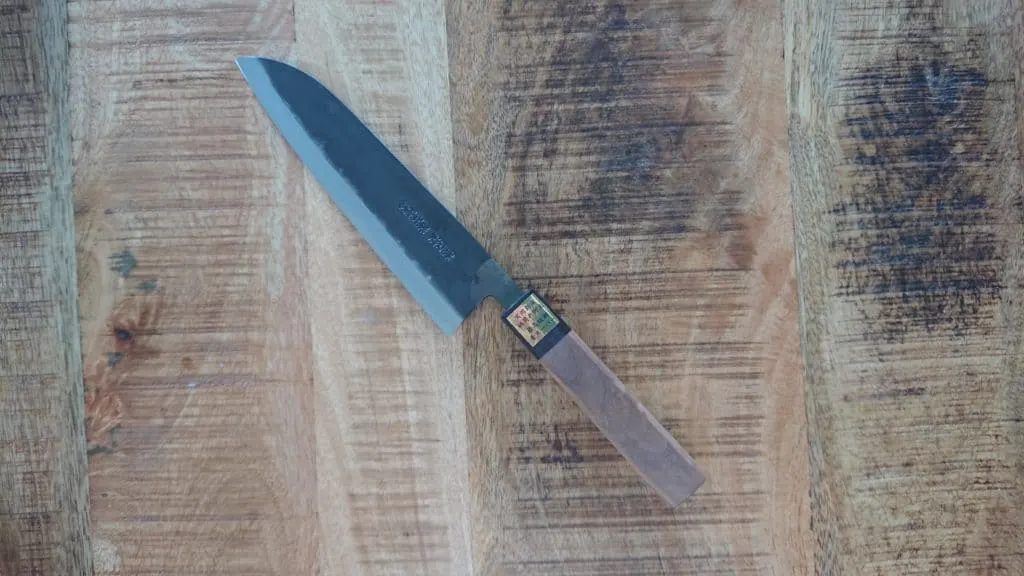
The Santoku name actually means “three purposes,” which gives you a hint of the multi-purpose designation of this knife.
The purposes that this knife is designed for include cutting meat, fish, and vegetables. This makes this knife ideal as a general-purpose kitchen knife, including the quick preparation of vegetables.
The versatility of this Santoku makes it a popular choice, and it has gained favoritism in the West as one of the most common Japanese-style kitchen knives used in Western homes and professional kitchens.
The blade of the Santoku is generally between 5 inches and 8 inches in length. The spine of the knife slopes down to the tip of the knife in the traditional sheep’s foot-shaped tip, meeting the tip at about a 60-degree angle.
The cutting of this blade is usually straight, but some modern versions may have a slight curve which helps when using the knife to cut vegetables using the rocking action of the knife.
When the knife has a traditional handle installed on it, it is called a Wa Santoku, and this handle design is lightweight and shifts the balance point of the Santoku closer to the tip of the knife. This gives a more precise and nimble feel to these knives, which allows fast processing of vegetable ingredients.
The Santoku also has a fairly high blade which gives clearance for the knuckles of the knife user when the knife is being used to chop vegetables.
This knife is lightweight and versatile, which has acted to increase its popularity as a mini-chefs knife in kitchens around the world.
If you are interested in buying a high-quality Santoku knife, we recommend checking out this knife made by the Yoshihiro company (Amazon link).
4. Gyuto
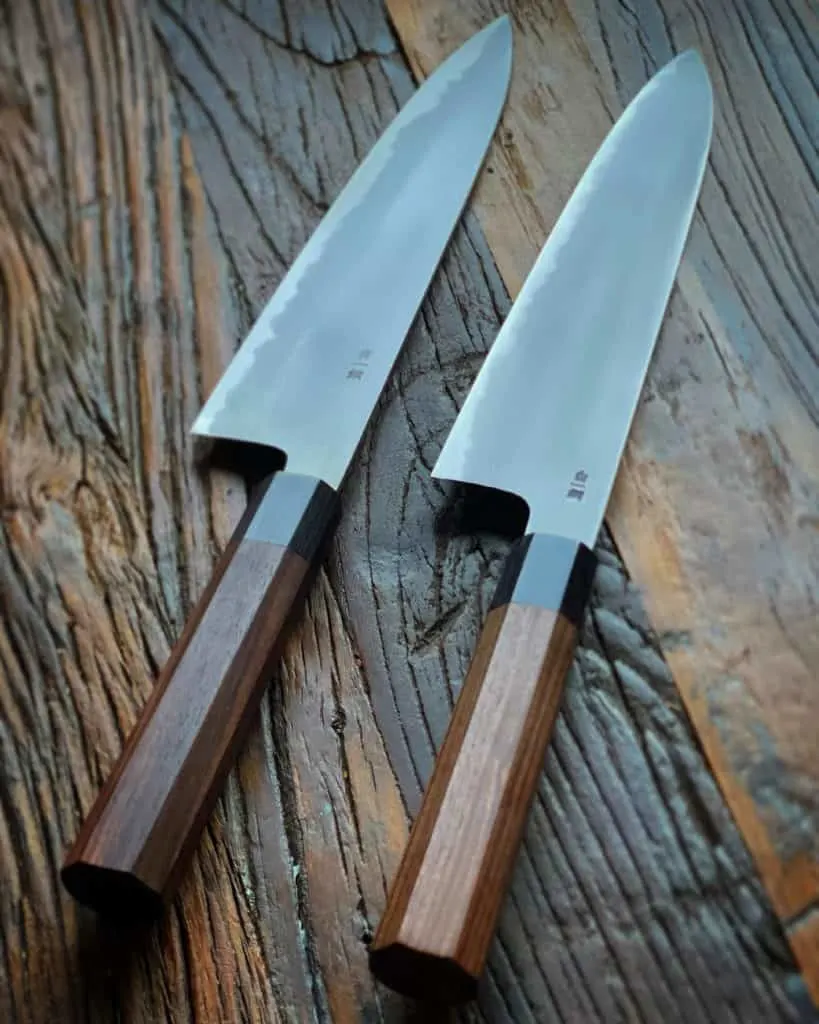
The Gyuto is the big brother of the Santoku in that it is similarly shaped and has a similar function in the kitchen as the Santoku. The gyuto is the equivalent of the Western chef’s knife, and as such, it is also considered to be a multi-purpose blade.
The knife performs very successfully in cutting meat, poultry, fish, fruit, and of course, vegetables. The blade shape differs from the Santoku in that it does not have the steel angle of a sheep’s foot tip but rather tapers evenly towards a sharp point.
The cutting edge of the knife is straight until the last one-third of the length towards the tip, where it starts to curve up towards the point.
This curve towards the tip makes the knife very versatile for use in many different cutting techniques, including the rocking cutting motion to chop vegetables extremely quickly and accurately.
Another aspect of the Gyuto that adds to its popularity is the range of sizes that it comes in. The Gyuto can be anywhere from 7 inches in length to 10.6 inches in length.
The most popular lengths are Gyutos which are within the 7 to 8.2-inch range. Longer knives are generally considered more the domain of the professional chef or at least a very serious amateur chef!
If you are interested in buying a high-quality Gyuto knife we recommend checking out this knife made by the Yoshihiro company (Amazon link).
TIP: The best way how to keep your Japanese knives sharpy is using whetstones! If you don´t know how to choose and buy whetstones, click the article below for the ultimate buyer´s guide!
How To Choose And Buy A Whetstone: The Ultimate Buyer’s Guide
5. Bunka
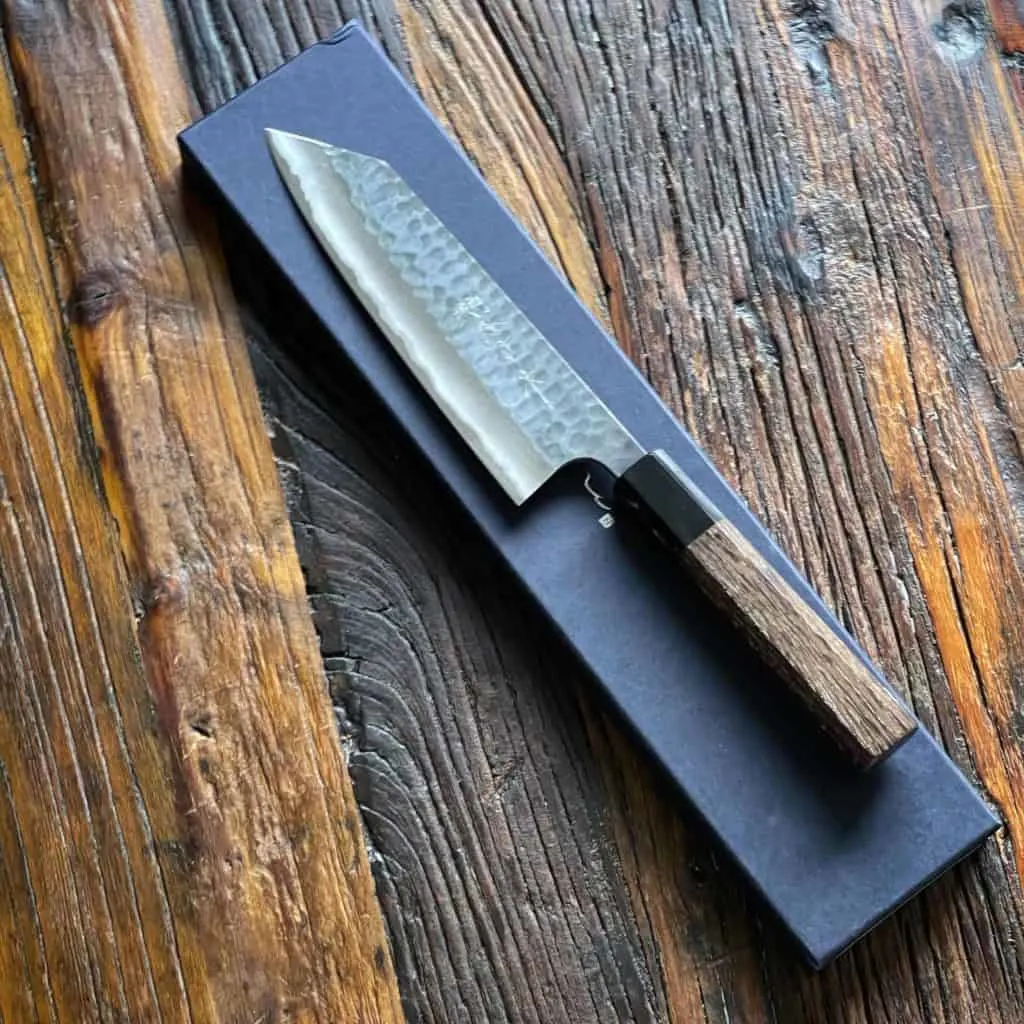
The Bunka is another multi-purpose knife that used to be almost as popular as the Santoku in the Western world, but the popularity of this knife seems to have waned somewhat over recent years.
The Bunka has a wider blade than the Santoku, which actually lends itself better to the chopping of vegetables. The reverse tanto tip of the knife gives a very sharp pointed tip which is useful in the processing of meats in the kitchen.
The reverse tanto tip also adds to the aesthetic of the knife, giving it a very appealing shape. The cutting edge of the knife has more of a curve to it than the Santok, but the curve is slight.
This gives it a limited ability for the rocking chopping motion to chop vegetables, but it excels at push cutting and chopping.
The Bunka would be used on any occasion in the kitchen that would call for a Gyuto or a Santoku since all three of these knives perform similarly in the kitchen.
The Bunka generally comes in lengths that are similar to the Santoku, lengths between 5 and 8 inches.
If you are interested in buying a high-quality Bunka knife we recommend checking out this knife made by the Spyderco company (Amazon link).
6. Funayuki
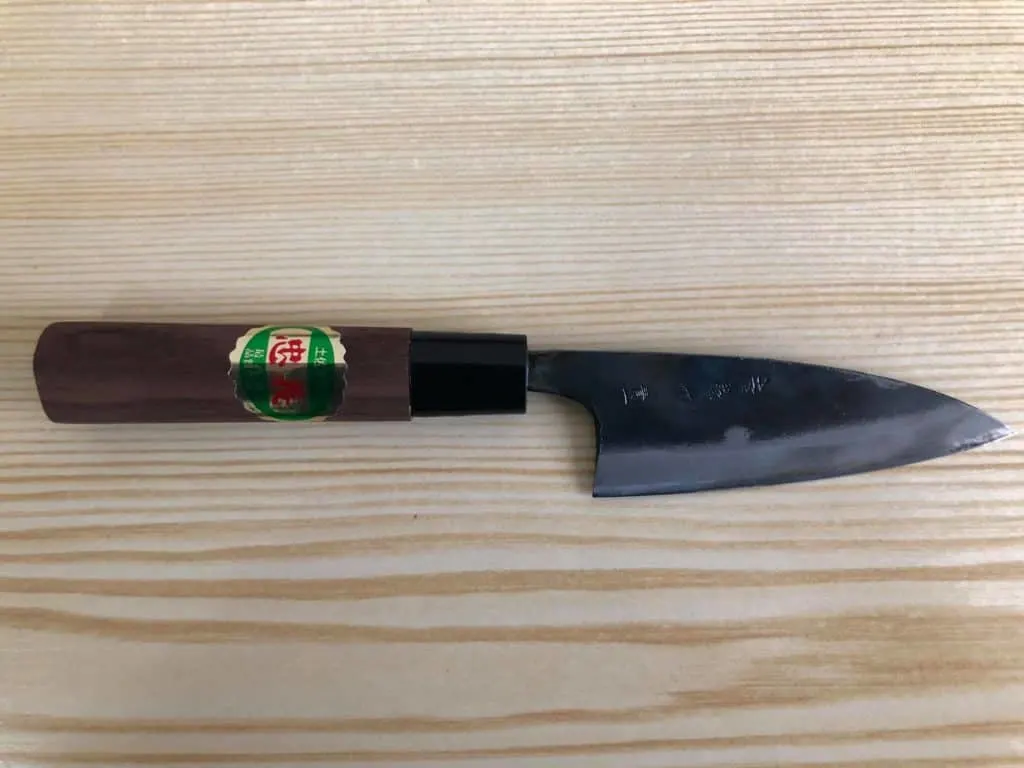
The Funayuki is another multi-purpose knife that was designed to be a robust hard-working knife for fishermen aboard their boats.
This means that the Funayuki was traditionally used for many purposes onboard fishing boats, from processing catch of fish to preparing the food of the fishermen.
The knives are versatile for the cleaning and filleting of small to medium-sized fish as well as for cutting meat and fruits, and vegetables.
The profile of the cutting edge has a slight curve to it but is relatively flat. It can be used for limited rocking-style vegetable chopping, but it performs best for push and pulls cuts and light vertical chopping, mostly with the heel of the knife. The overall profile of the Funayuki closely resembles that of the Santoku.
Even though this knife is durable and multi-purpose, it is not intended to debone meat or cut through poultry bones, frozen foods, or similar hard ingredients.
The Funayuki is a shorter blade than many of the knives already mentioned, which gives it a handy size in the kitchen for smaller vegetable processing tasks. The general blade length range of these knives is from 4.7 inches to 7 inches.
The 4.7-inch to 6.5-inch knife lengths are the most popular lengths for the Funayuki. These knives are often used as complimentary knives to the larger Gyuto or Santoku knives.
The Funayuki comes in both double and single bevel variations, which gives the buyer choice depending on their preference.
If you are interested in buying a high-quality Funayuki knife we recommend checking out this knife made by the Yoshihiro company (Amazon link).
TIP: Do you know the difference between Funayuki and Deba knives is? Check out the main differences between these two Japanese knives in the article below:
Funayuki Vs. Deba: The 5 Differences That Matter
7. Mukimono
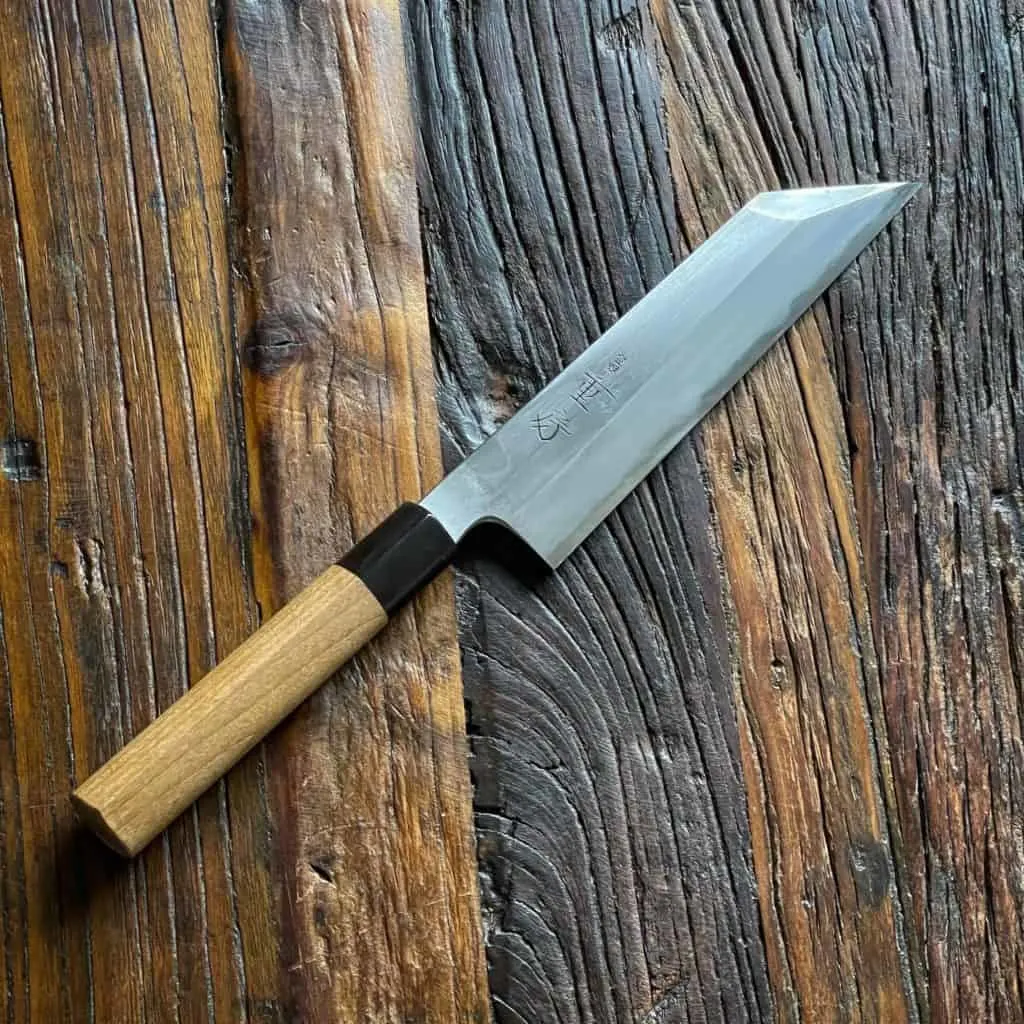
The Mukimono knife, or more accurately, the Mukimono Hocho, is a very useful knife for vegetable preparation because of its smaller size and thin blade.
It is a general-purpose vegetable processing knife that is most often used for slicing vegetables and light chopping on smaller vegetables such as radishes.
The main purpose of the Mukimono was in the Japanese culinary art of Mukimono, which is creating decorative garnishes, and also the art of Kazari-Giri, which involves the decorative carving of vegetables.
The reverse tanto tip of the blade of the Mukimono produces a very sharp pointed tip that is ideal for delicate fine decorative work.
The cutting edge of the knife is straight and flat, with no curve or belly to the edge. This makes the knife great for push-and-pull cuts and straight up-and-down chopping but not ideal for the rocking chopping action.
Mukimono knives can be quite small, starting at 3-inch blades and going up to 8.2 inches. The most popular length of blades is between the 6-inch and 7-inch range.
Even though these knives are quite small, they are very useful in the kitchen for chopping vegetables, even if their main function is decorative cutting work on vegetables and garnishes.
If you are interested in buying a high-quality Mukimono knife, we recommend checking out this knife made by the Yoshihiro company (Amazon link).
8. Petty
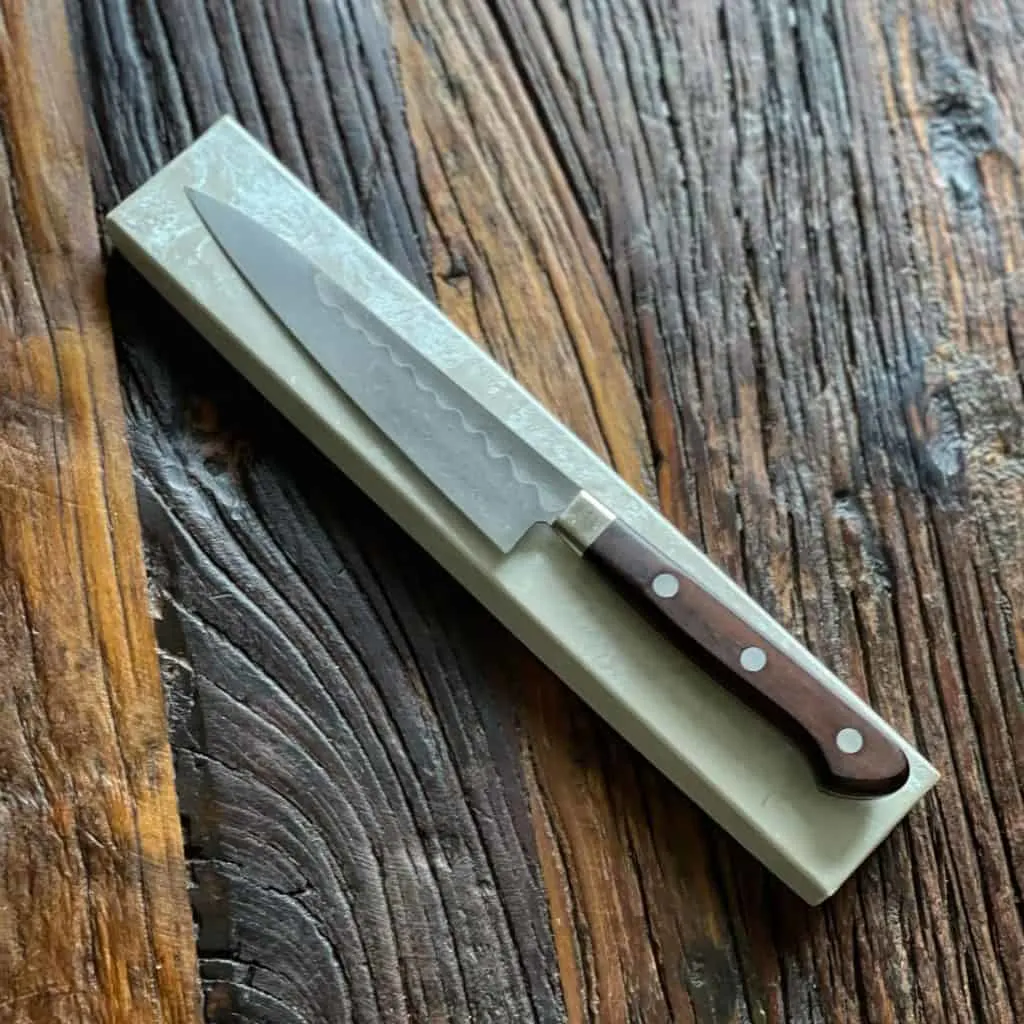
The Petty is the Japanese knife equivalent of the Western kitchen utility knife or the paring knife. The shape of the blade of a Petty knife can vary greatly, but the most common shape is a blade profile that is very similar to a Gyuto or a Santoku knife, only much smaller.
The Petty is usually a small knife that starts in the range of a 3-inch blade, ranging up to an 8-inch blade. The shorter versions are used for more delicate work, but a Petty with a blade length in the upper regions of its long-range can prove to be a useful vegetable chopping knife.
If you are not overly troubled about the perfection of the cut but rather to get the ingredients chopped finely, then reaching for a Petty would be acceptable.
The cutting edge of this knife is fairly flat and straight, with a slight curve up to the tip of the blade. This allows for the Petty knife to be used in the rocking chopping motion but only in the processing of smaller vegetables.
The blade on the Petty does not have much height, so it does not leave much room for your knuckles above a chopping board for fast work.
If you are interested in buying a high-quality Petty knife, we recommend checking out this knife made by the Yoshihiro company (Amazon link).
TIP: A petty knife is often compared with Honesuki or Funayuki knives. Do you know what the differences between these knives are? Find out more in the articles below:
Honesuki Vs. Petty: The Main Differences You Should Know
Funayuki Vs. Petty: Which Knive Is Better?
Which Japanese Knives Should You Buy For Chopping Vegetables?
Because Japanese knives are mostly built with a specific purpose in mind, it is difficult to select only one knife as the perfect vegetable chopping knife for your kitchen. The ideal would be a combination of two knives.
The best Japanese knives for chopping vegetables would be a combination of a Nakiri and a Santoku or a Nakiri and a Gyuto. The purpose-built function of the Nakiri makes it the primary choice, while the versatility of the Gyuto and the Santoku make them the perfect complementary knife to the Nakiri.
The Nakiri will give you great service in the kitchen for chopping, slicing, and preparing vegetable ingredients.
Having another knife, such as a Gyuto or a Santoku, to perform tasks such as the rocking chopping action and other finer tasks will make this combination pretty much all you will need in the kitchen to chop your vegetables.
Conclusion
When you are considering getting Japanese knives, you need to consider the type of cooking that you do most frequently.
This will help you to choose a combination of knives that will be not only great for vegetable chopping and processing but also have other uses in your food preparation.
This will give you the opportunity to not only experience the joy of using Japanese knives to process your vegetables but also experience their prowess in other tasks in the kitchen as well!
TIP: If you are interested in buying Japanese knives, we personally use nipponshop.cz to buy Japanese knives and sharpening stones. You can find high-quality Japanese knives and whetstones there. Robert Rous, the shop owner, is an expert and always gives great advice. The shop offers worldwide shipment, so feel free to check it out.
TIP: All Japanese knives are made for a purpose. So you need to use them for what they are made for. Find out what you should not cut with Japanese knives in the article below:
Complete List: What NOT TO CUT With Japanese Knives & Why?
